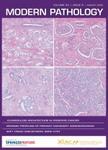版权所有:内蒙古大学图书馆 技术提供:维普资讯• 智图
内蒙古自治区呼和浩特市赛罕区大学西街235号 邮编: 010021

作者机构:Univ Insubria Anat Pathol Unit Dept Human Morphol Sect Anat PatholCtr Insubre Biotecnol Salute Uma I-21100 Varese Italy Osped Circolo Varese Varese Italy IRCCS MultiMed Sect Anat Pathol Milan Italy Oncol Inst So Switzerland Lab Expt Oncol Bellinzona Switzerland Univ Pavia Dept Appl Hlth Sci I-27100 Pavia Italy
出 版 物:《MODERN PATHOLOGY》 (现代病理学)
年 卷 期:2011年第24卷第1期
页 面:126-137页
核心收录:
学科分类:1001[医学-基础医学(可授医学、理学学位)] 10[医学]
基 金:University of Insubria Varese Italy
主 题:chromosomal instability colorectal carcinoma hierarchical clustering analysis molecular classification
摘 要:This work has evaluated the potential superiority of a morphomolecular classification based on the combination of clinicopathologic and molecular features of colorectal cancers. A cohort of 126 colorectal carcinomas was investigated by unsupervised hierarchical clustering analysis to combine 13 routinely assessed clinicopathologic features and all five molecular markers recently suggested by Jass classification to distinguish four molecular subtypes of sporadic colorectal carcinomas. Survival analysis was assessed by a Cox proportional hazards model. A clear separation into three prognostically significant groups was identified: cluster A and cluster C were associated with good prognosis and cluster B with poor prognosis (P=0.006). Clinicopathologic and molecular features of cluster A and cluster B tumors were strongly concordant with colorectal cancer profiles characterized by microsatellite instability or by chromosomal instability, respectively. The clinicopathologic features of cluster C tumors were suggestive of a less aggressive disease than cluster B tumors. Genetically, they appeared intermediate between cluster A and cluster B tumors, as they were mainly microsatellite stable tumors showing high levels of both MGMT methylation and loss of heterozygosity. Chromosomal instability was significantly lower in cluster C than in cluster B tumors. A more accurate tumor classification should combine the prognostic power of clinicopathologic parameters with molecular biomarkers that provide information regarding the natural history of the cancer. Hierarchical clustering seems to be a useful, promising and powerful tool for further translational studies and should lead us to define a diagnostic and prognostic signature for different carcinomas. Modern Pathology (2011) 24, 126-137;doi:10.1038/modpathol.2010.179;published online 17 September 2010